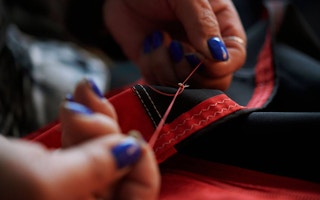One of fashion’s most enduring trends is to draw inspiration from other cultures’ traditional arts and crafts.
But the extent to which fashion houses profit from these designs without acknowledging their origins has sparked accusations of cultural appropriation in recent years.
Amid this growing backlash, luxury outdoor brand Canada Goose is paying homage to the Inuit, who originally created the fur-lined cold-weather parka coat that the company has become famous for selling.
This week it launched a new business venture, Project Atigi, which aims to acknowledge and support Inuit communities in Northern Canada.
“
As we’re moving forward into modern times, indigenous cultures are being acknowledged for their ingenuity and their craft.
Mishael Gordon, seamstress, Project Atigi
Canada Goose commissioned 14 Inuit seamstresses to each make a coat of their own design, using fabrics selected by the company. The seamstresses own the copyright for their coats, rather than Canada Goose.
“As we’re moving forward into modern times, indigenous cultures are being acknowledged for their ingenuity and their craft,” Mishael Gordon, one of the Project Atigi seamstresses, told the Thomson Reuters Foundation.
“I felt like this was an example of appreciation of indigenous culture, not appropriation,” she said.
Canada Goose set up Project Atigi as a social enterprise, which is a business that seeks to do good as well as make profit, so it would benefit the Inuit directly.
The seamstresses were paid for their work and all the profits will go to a charity that works to improve the health and wellbeing of Inuit in Canada.
$900 coats
Dani Reiss, president and chief executive of Canada Goose, said the company had a responsibility to help the northern region of Canada, where the company originates from, to prosper.
“We know that ‘the north is open for business’ and this is our way to create social entrepreneurship in the region,” he told the Thomson Reuters Foundation in an email.
Canada Goose, which was founded in Toronto 62 years ago, sells coats for about $900. The Inuit designs are on display in its New York store and will be sold online this month at between $5,000 and $7,500.
It is the company’s first foray into social enterprise and follows protests by animal rights activists over the use of fur and duck feathers in its coats.
Gordon explained animal fur was still widely used in Inuit culture to protect them from the cold.
She said she believed Project Atigi was not motivated solely by good publicity and would benefit the Inuit people.
“They are making themselves look great, but they are making Inuit seamstresses look great as well, because they are showcasing our artwork,” she said.
But Riley Kucheran, an expert on indigenous fashion design, said the contribution to charity amounted to “a drop in a very large bucket”.
“The partnership does some good work in bringing attention to the brilliancy of Inuit design, but I think Canada Goose could do more,” said Kucheran, who is studying for a PhD at Ryerson University in Toronto, in an email.
“We’ll have to wait and see if it’s truly a reciprocal relationship.”
Beg, borrow, or steal?
Awareness of cultural appropriation is growing, but big brands still trip up.
Designer Isabel Marant was accused of copying an indigenous Mexican design for a dress in 2015.
Two years later, Chanel was accused of appropriating Aboriginal culture when it started selling at luxury boomerang for $1,930.
Because social enterprises typically reinvest profits back into the business or a cause, they are in a position to address this wrongdoing by directly giving back to the workers or communities that build them.
When fashion house Dior was accused in 2017 of copying a traditional design from Romania’s Bihor region, it prompted a local fashion magazine to set up a company to help traditional artisans and keep their techniques alive.
Bihor Couture employs local artisans to make the traditional garments and has also raised money to support a craft school in the region.
Australian social enterprise Kirrikin prints Aboriginal designs on luxury silk. It employs Aboriginal artists, who receive a percentage of the profits from sales of their designs.
There are also social enterprises taking a similar approach in beauty.
Shea Yeleen sells shea butter, supporting the women cooperatives that produce it in West Africa by paying a living wage, offering training and access to healthcare.
This story was published with permission from Thomson Reuters Foundation, the charitable arm of Thomson Reuters, that covers humanitarian news, women’s and LGBT+ rights, human trafficking and slavery, property rights, social innovation, resilience and climate change. Visit http://news.trust.org to see more stories.








